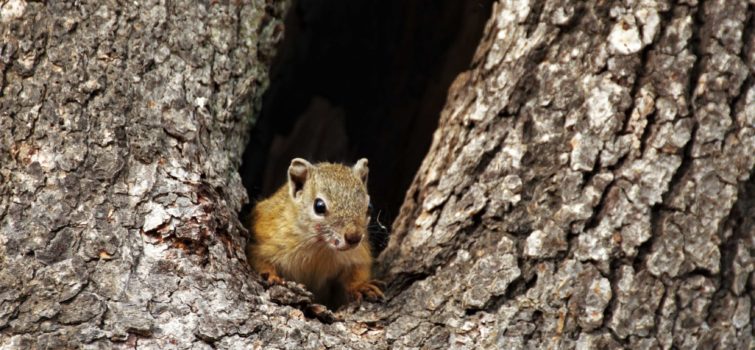A Home That Makes A “Hole” Lot Of Sense
Observation: the active acquisition of information from a primary source using our senses. A critical part of being a guide, or even simply living in a natural environment, is possessing the proverbial ‘power of observation’ – taking time to notice the small things, those things less ordinary.
Each time we exit the reserve and travel to town for provisions or head towards our next adventure on our time off, we are challenged by what we see and more recently what we don’t. I have wondered why on the Welgevonden Game Reserve (WGR) we see the African grey hornbill quite commonly but not the southern yellow-billed hornbill or the red-billed hornbill. If you head out of the main gate towards the town of Vaalwater, you will start to see both these species. What is it that restricts them coming onto the reserve? I originally considered that this must have to do with suitable nest sites or simply the lack thereof. The diet of all three hornbill species in the area is too similar for there to be segregation as a result of food differences, so it must have to do with breeding sites. Having investigated this deeper, it is clear that the nesting requirements of all three species are quite similar and so this deepens the question of why?
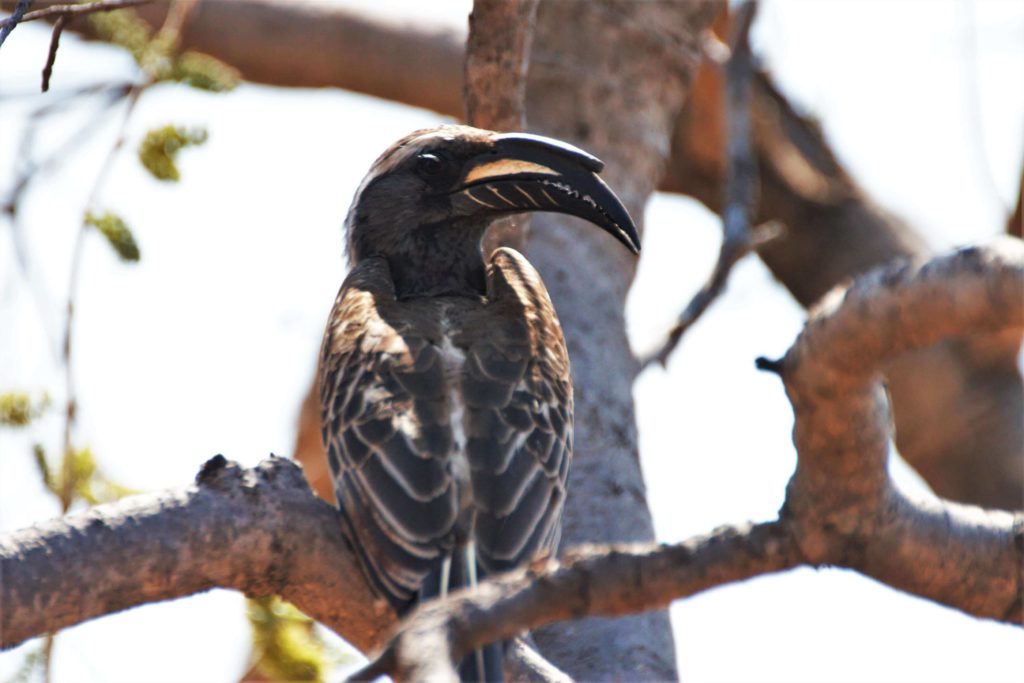
In almost four years that we have been on the reserve, I have been watching where certain species of birds have been nesting in my fervent search for an African grey hornbill nest. In most of the other reserves I have worked on or visited in the last 30 years, I have been able to find southern yellow-billed hornbill, red-billed hornbill, and southern ground hornbill nests. They are always fascinating. It’s a great source of entertainment watching the male attend to his locked-up family. There is much information about the nesting habits of hornbills as a result of their interesting nest habits. On a reserve about 60kms north of WGR where Jessica and I spent some time, we witnessed southern yellow-billed hornbills nesting close to the road into camp and on a daily outing would stop and see what was happening. The nest was about 3 meters up so we could not look into it, nor did we want to disturb them, but standing under the tree you could hear the mother and her brood moving around in the nest and ‘calling’ to the male, presumably for food. We were lucky enough to find the skull remains of a hornbill outside the nest amongst the growing pile of faeces that the female and her brood had ejected from the nest.
Nests – Prime Real Estate On The Reserve
Holes in trees also referred to as cavities provide for the hornbill nesting needs, but they are not the only ones who are on the lookout for this prime real estate.
All birds need to make use of a nest in some form, even if it’s not their own nest to begin with. A nest is described as an external construction that aids the survival and development of the eggs and young. So, the sole purpose of the nest is therefore to provide warmth and safety to the developing eggs and chicks. There are three main types of nests recognised in birds. Nests where:
- Incubation is done by the environment:
- Here the eggs are buried in the ground and no incubation or brooding is done by either parent
- The nest is guarded usually by the male
- Examples of these birds are the megapodes, which are distributed mainly in the larger Australasian regions and include the Australian brushturkey
- Incubation is done by the parent/s mostly:
- Dig or use a nest cavity – e.g. woodpeckers
- Open nest where there is no canopy – most birds including eagles
- Roofed nest, where there is a distinct top – e.g. sunbirds
- Compound nest, where the nest is built and cared for by groups of birds – e.g. sociable weavers
- Incubation is done by other birds:
- As in the Brood Parasites – e.g. cuckoos
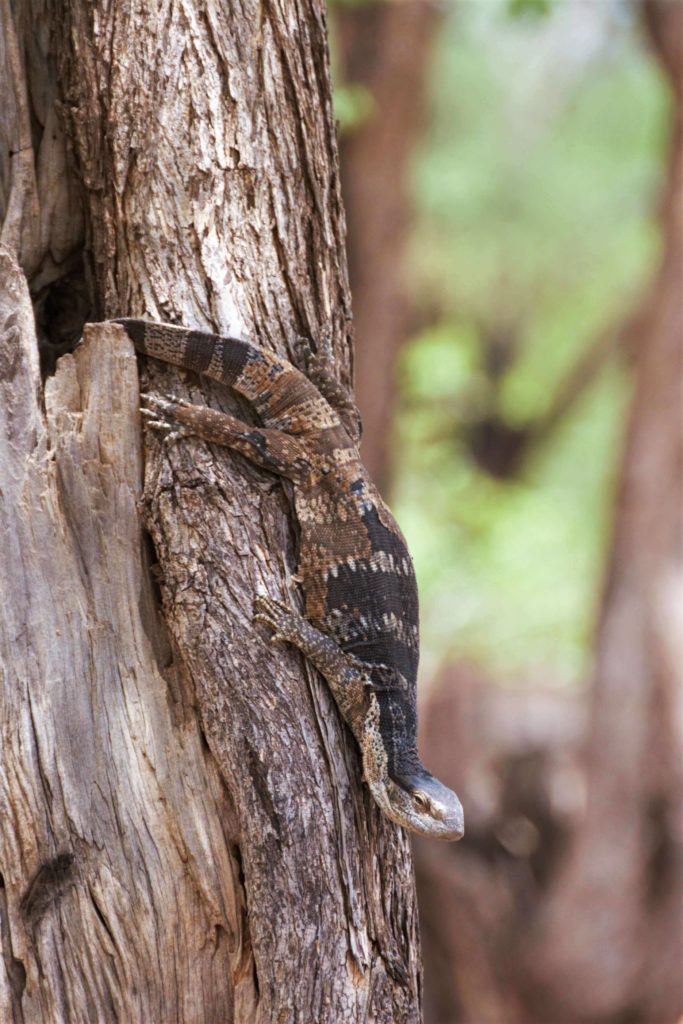
Building a nest expends a lot of energy and a bird will make 1,000 or more trips in collecting and bringing sufficient material to build their nest. The smaller the bird, the more elaborate and important the nest becomes. Smaller birds lose more energy and warmth and the need for a well-built nest is greater. Securing warmth and safety for their eggs and young is, therefore, more acute. Nest design and function in different species is also a result of a.) the amount of time it takes to build the best, b.) the environment and c.) the level of parenting required (altricial vs precocial chicks).
Cavity nests in trees are either natural, as in a knot in a tree’s wood formation, or from disused nests from other bird or animal species. All cavity nests are highly sought after and result in fierce competition between species. Globally there are close to 10,000 recognised species of birds, all with their own nest requirements. Of this at least 1878 species are cavity nest species who utilise tree cavities, this excludes species who use cavities in sandbanks or other, such as manmade structures. This means 18% of the world’s total bird population are all looking for prime real estate offered in trees.
Of the 1878 species:
- 18% of these are primary excavators such as woodpeckers
- 72% of these are non-excavators, using the cavities made by other species
- 10% of these may excavate or use existing cavities
Of all the birds in the world, 17% of them rely on woodpeckers to create nest sites for them to use. This is quite a responsibility to have.
In southern Africa over a hundred species of birds nest in holes, of which about 90 species are attracted to cavities in trees for nests. These tree-hole-nesters mostly use natural cavities caused by ‘stem-rot’. Two families of birds, however, have developed the ability to excavate their own cavities – the woodpeckers and the barbets. These are referred to as primary cavity users (PCU). As we have seen there are many birds who rely on these ready-made cavities for their own nesting requirements as stated earlier. Families in southern Africa included in this group are the parrots, owls, kingfishers, rollers, hoopoes, and hornbills to mention a few. These are referred to as secondary cavity users (SCU). Almost 80% of these secondary cavity users prefer natural cavities though, as opposed to those made by other species. Most of these species also prefer cavities in dead wood as opposed to live wood. Even the primary cavity users prefer dead wood to live wood.
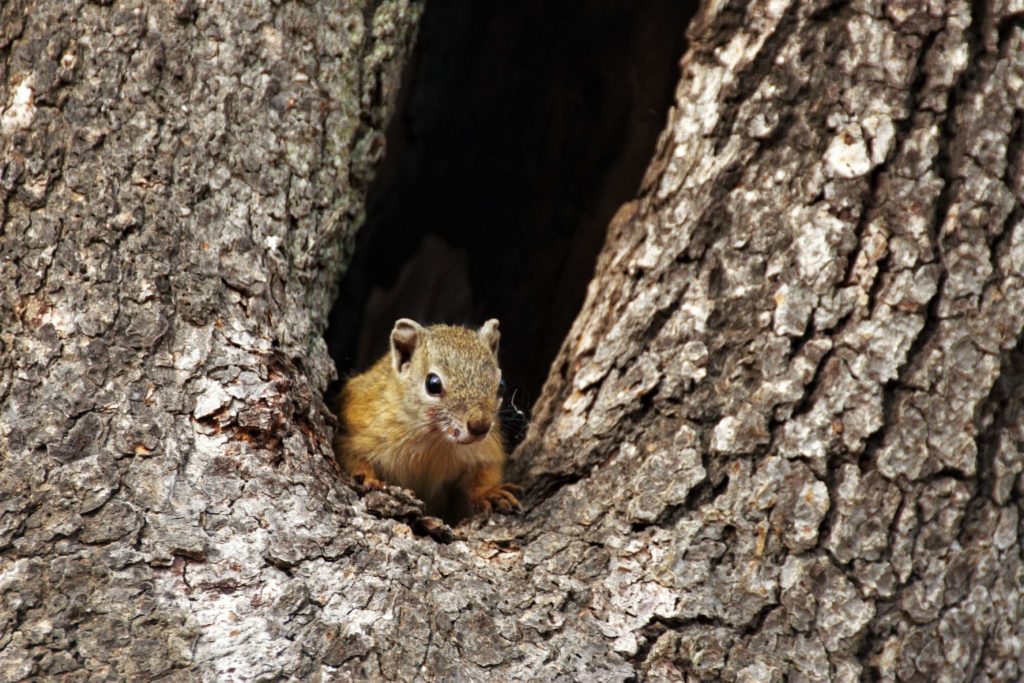
Cavity Nests – A Guide For Potential House Hunters
Cavities in trees are used for nesting and roosting by birds, mammals, amphibians, and insects. They are used to fulfil different behavioural needs such as resting, roosting, breeding, feeding and hiding.
In ecosystems where natural cavities are lower in density, woodpeckers become key components, providing habitat for both bird and mammal SCU. Birds are often used as bio-indicators of ecosystem performance, especially in areas that are human-modified systems. They can tell us by their presence if an area is ‘healthy’ or not. An example of this is a city. In the 1980s the grey go-away bird was not seen in and around Johannesburg, which was an area that fell outside of its natural distribution. As the city grew and more shade trees were planted, including ornamental fruit trees for gardens, these birds began moving into the city in search of this rich highly sought-after new source of nourishment. Simply put, they had indicated a change in the ecosystem.
In natural ecosystems, it is important to have a good balance. Both the PCU and SCU species carry important ecological advantages. Birds have an impact on pest control in many areas but also fulfil critical ecological roles in seed dispersal and pollination. Without enough of the excavators in a system, there would be an insufficient habitat for those who are interested in ready-made cavities. This would upset the balance.
As mentioned earlier, cavity-nesting species prefer dead wood to live wood. Ecosystems, therefore, need to provide enough dead wood for these species to nest and thrive. Cavities in mature trees are preferred by most nesting species, although nest selection is influenced by other factors such as:
- Habitat conditions – availability of food, water and lack of predators
- Life history traits – what has been learned and taught through generations
- Tree preferences – shade offered to shield cavity entrance, food
Studies have shown that both PCU and SCU species prefer mature trees that are >30cm in diameter at what is our chest height. For the PCU species, trees that are more susceptible to insects and fungus, with low resin levels are also more conducive to cavity formation. For the SCU species, once a cavity is located in a suitable tree, the nest selection criteria include:
- Depth of the cavity
- Size of the cavity to the size of the bird
- Orientation of the entrance
Other determining factors, which are less limiting are:
- Height above ground
- Vegetal cover – concealment of the entrance
- Neighbouring vegetation – due to habitat edge effects and competition
In forestry terms, standing dead trees are referred to as ‘snags’, and this is what these cavity-nesting birds are after, but they are not the only ones.
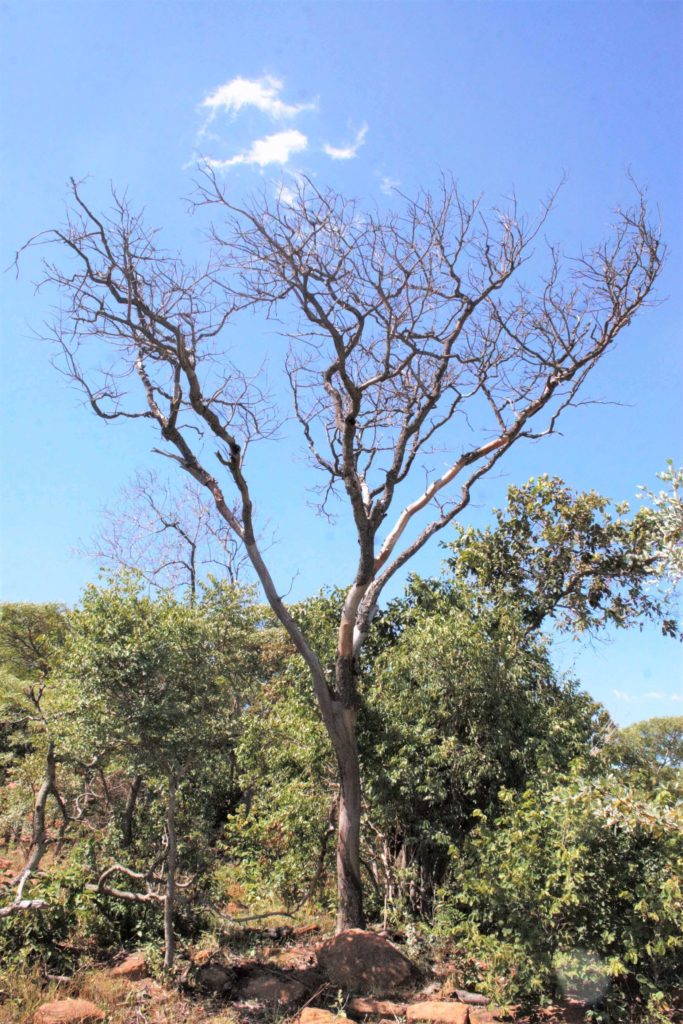
A Declining Real Estate Market
In natural and human-modified forests in South Africa, there is a growing concern of the overexploitation of dead wood. Standing dead trees or snags are important in the ecology of many forest animals (birds, mammals, and amphibians), fungi, moss, lichen, and insects. In Africa, there is pressure to use these dead trees for their wood. The removal of this wood in forest systems has a vast negative impact on those cavity-nesting bird species. In Africa, wood is an important component to fulfil many people’s energy requirements. In South Africa, on average of 12% of our population use wood as a primary energy source, although in some regions this is much higher. In other parts of Africa such as the Central and Eastern regions, up to 90% of the population rely on wood to fulfil their primary energy needs.
In natural forests that are managed or conserved, the diversity management of habitat is critical to all species. Cavity-nesting species are under threat here too as other key ecological species take preference in management principles. In many areas where elephants are conserved, their movements in and out of ecosystems is drastically hindered by communities, fences, and other manmade structures and barriers. In these areas where elephant densities have increased, there will inevitably be fewer mature trees with dead wood. Both fire and elephant damage lead to a drastic loss of nesting sites and material. Studies have shown that where elephant densities >0.5 / km2, savanna ecosystems will convert to shrubland or grassland. This is a significant change for systems with PCU and SCU bird species. Currently, in Africa, natural elephant densities are >3/ km2.
The overall deforestation of areas or habitat loss also impacts on bird feeding sites too, not only suitable breeding sites.
The Cape parrot, endemic to the forest mist belt in eastern South Africa has suffered great losses in numbers in the past 30 years. There are estimated to be between 500–1,000 individuals left. Their losses are due to the severe habitat loss of their preferred Podocarpus (yellowwood) forests. These birds are food and nest specialists and so the deforestation in these areas has led to food and nest site shortages. South Africa has 41 bird species who are true forest or forest specific species, which is about 6.5% of our total avifaunal species (excluding marine), and all of them are in danger of the same fate as the Cape parrot.
Tree-Cavity Nesting Neighbours
Within the reserve, there are several of both PCU and SCU bird species. Each has a role to play and the conservation management of the reserve takes care to ensure they too are taken care of.
Cardinal Woodpecker
Sitting on the Indaba deck after breakfast with a cup of coffee, watching the kudu and zebra come down to drink is a treat. The quiet of the bush is interrupted by a constant tapping somewhere off in the syringa trees beyond the waterhole. It is unmistakably a woodpecker. Recently we have been seeing a cardinal woodpecker around the house and in camp. I have not seen where they nest on the reserve but considering they are the key component to so many tree-cavity nesting species, it is only fair they are featured.
It is our most common woodpecker and hence must play a large role in nest formation. Some interesting points about cardinal woodpecker’s nesting habits:
- The nest is excavated by both male and female and takes from 2–3 weeks to complete.
- The hole is oval-shaped and is usually on the underside of a sloping stem, anything from 1– 4 meters above ground [16].
- Each year a new nest hole is excavated and not in the vicinity of the previous years’ nest.
- They are monogamous and breed once in a season [15].
- Usually very vocal and territorial they remain quiet and unobtrusive during brooding.
- 1–3 eggs in a clutch (oval and glossy white), taking 13 days to incubate, both parents playing their part.
- The chicks will emerge from the nest after 27 days, being fed by both parents.
- These birds are subjected to brood parasitism, usually by honeyguides.
They create roosting holes as well, which have a larger entrance than their nesting holes. During non-breeding, the pair will make use of the same roost hole each night. These holes will inevitably be used as well by other cavity nesters.
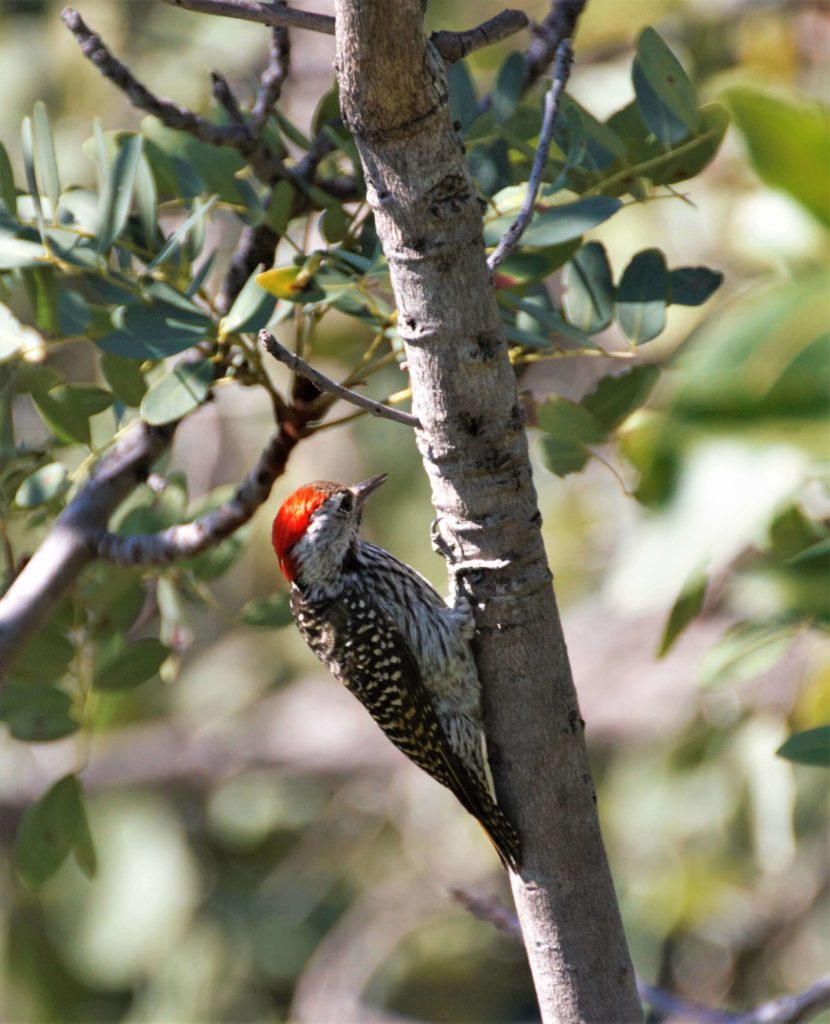
African Grey Hornbill
I continue my search. The African grey hornbill like most of the African hornbills, nests in a natural tree-cavity and occasionally in an old woodpecker nest. Some of their nesting habits:
- The cavity is about 2–4 meters above ground with a wide enough entrance in the shape of a slit, longer than wider.
- The cavity usually has a hollow chimney, into which the female will retreat if under threat.
- The female will enter her hole about a week before egg-laying commences.
- She will seal herself into her nest chamber using her faeces to block the entrance hole, leaving only a slit for the male to feed her through.
- The male will also pass her vegetal matter, which she uses to line the nest. She will remove her moult feathers extracting them from the nest through the slit.
- The female lays her eggs (oval and white) at irregular intervals, up to 5, which she does over a 7-day period [15].
- Incubation takes 3-4 weeks and starts as the first egg is laid.
- She will remain in her chamber for 6-8 weeks in total.
- Nest-holes are reused and often following other nesting species using the hole first.
- After 45 days, the chicks will emerge and continue to be fed by both parents.
- The oldest chick exits first, and the hole is re-sealed by the chicks [16].
This is intensive nesting behaviour and therefore they will only brood once in a season. They have a fairly high success rate of fledgling survival, although the nests are often robbed by chacma baboons and rock monitors.

Red-Billed Oxpecker
I have watched two nests on the reserve over the past four years and have enjoyed watching the young emerge and take to the surrounds in their newfound freedom. In November, on a morning drive, we came across an old buffalo bull on the river road that runs west parallel to the Taaibos River. While watching him feed close to the road, we were entertained by a pair of red-billed oxpeckers that suddenly emerged from a syringa tree just in front of us. This was clearly their nest. After a while we noticed that three individuals went into the nest, emerging a little time later. They were not carrying food or nesting material into the cavity so perhaps this was early stages in the breeding season. Oxpeckers are known to ‘cooperatively breed’ where the breeding pair will be helped by up to seven other adults to raise their clutch, aiding during feeding.
- Typically, they nest in a tree cavity that is on average 8m above the ground
- The entrance to the nest we found was about 2m above the ground from where the birds then descended to the nest probably about just under 1m.
- Having a top entrance is typical of oxpecker nests.
- At the bottom of the cavity, oxpeckers will build a platform or pad, lined with dung, grass, and mammal hair collected from their hosts while feeding.
- Nest sites are regularly reused [15]. I have seen this with other oxpecker nests on the reserve. One in particular near Leopard Dam has had a brood each season for the past four years, the nest being a cavity in a dead branch in a large waterberry tree.
- Oxpeckers can brood up to 3 or 4 times in a season [15] and usually lay 3 eggs in each clutch.
- Incubation is around 12 days by both male and female.
- Interestingly, in most cavity-nesting birds, the eggs are white in colour. This aids the parents to see the egg when they enter the dark cavity nest.
- With regards to the oxpeckers, the eggs are white with mottled brown splotches. Perhaps seeing these eggs is easier when the entrance is from the top as opposed to a side entrance.
- Chicks will leave the nest after 30 days and are fed by the parents and assisted by helpers [15].
The young will continue to be fed even though they can self-feed. The young are easily identified by their dark brown heads and beaks lacking the striking colours of the adults. This they usually have after 7 months.
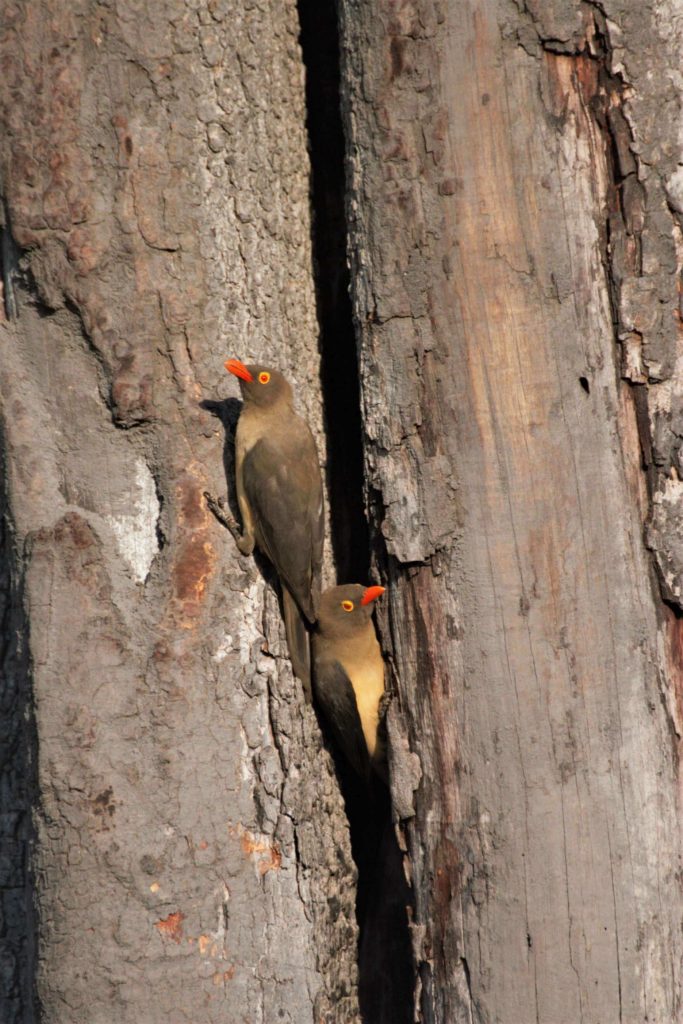
Lilac-Breasted Roller
Driving the Sterkstroom River valley is one of our favourite routes on the reserve and always provides for an excellent afternoon drive. The scenery is spectacular and being in this part of the reserve is food for the soul. Stumbling across a potential roller nest only makes it better. I had been watching this ‘snag’ for some time as the neat round hole from a woodpecker was clearly visible and simply too tempting to not want someone to nest in it. Rollers typically use nests made by bearded or Bennett’s woodpeckers [15]. Every time I approached the river crossing where this nest is, I would notice at least 1 lilac-breasted roller sitting close by, and on occasion there would be 2. At last, in January, I witnessed both adults entering the nest. This was a photographic moment.
- Living or dead trees are used, and the cavity can either be located on the upright stem or the underside of a sloping branch.
- Cavity bottoms are not lined with any material by the rollers but they will make use of whatever material has been placed in there by a previous occupant [15].
- Nests are also often reused.
- Noticing the birds in the area for some time before seeing any activity at the nest is common as the breeding pair will take occupancy of the nest a few weeks before egg laying [15].
- During this time, the pair are quite vocal and will chase other potential hole nesters from the area.
- Clutch size is usually 3 eggs with incubation taking up to 22 days.
- Both parents will incubate but the female does most of the work.
- The male may feed her while incubating or they will swap shifts giving them time to feed themselves.
- Rollers will usually only breed once in a season [15].
The time I witnessed this pair breeding was January 2019, and I have not seen them at the nest again this year. I believe there is too much disturbance at the nest as it is close to a road and there has been increased activity in this area. I will keep watching.
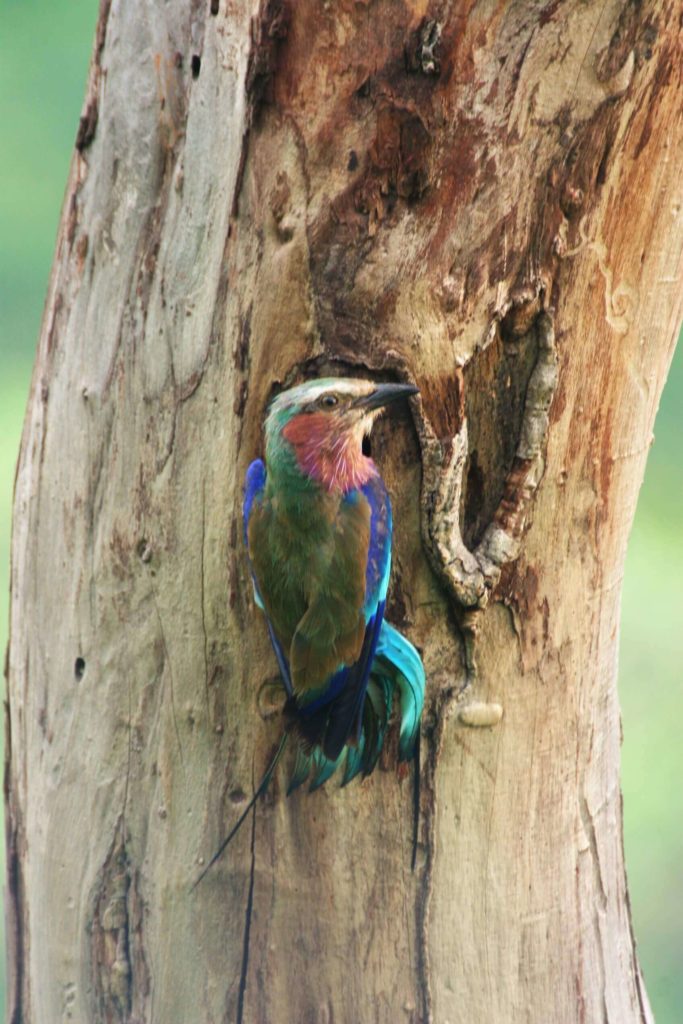
Final Thoughts
At Makweti Safari Lodge, sitting around the fire or under the stars or simply chatting about the afternoon and evening game drive excitement, we spare a thought for the declining numbers of our avifaunal friends. The Cape parrot as seen here, is under serious threat, and if not assisted and understood, this iconic species will no longer be a part of our birding lists. Conservation efforts are few and far between, but every bit helps.
Paging through our wine list looking for a delectable white wine to enjoy with your choice on our dinner menu, your attention will be drawn to how you too can play your part in preserving these birds. We list the AA Badenhorst Family Wines’, ‘Papegaai’, a white blend, which changes face each year and is as great as the cause they contribute to. Through their own efforts, some of the proceeds made from the sale of this unique white blend go towards The Wild Bird Trust’s Cape Parrot Project. Try it, and enjoy every sip, knowing you are helping in a small way to save our only endemic parrot in South Africa.
It will make a ‘hole’ lot of sense.
Text and photographs – Neil Davison
References:
- 30 years of personal observations by the author on various Reserves in South Africa including Welgevonden Game Reserve
- Martin & G. J. Broekhuysen, 1961, Some records of birds using the nests of others, Ostrich, 32:3, 104-106, http://doi.10.1080/00306525.1961.9633083
- O. Wirminghaus et.al., Conservation of the Cape Parrot in southern Africa, 1999, South African Journal of Wildlife Research, 29(4),
- E. Arnold & I.P.F. Owens, Cooperative breeding in birds: the role of Ecology, 1999, Behavioural Ecology, 10(5); 465-471
- A. du Plessis, The Effects of Fuelwood removal on the diversity of some cavity-using birds and mammals in South Africa, 1995, Biological Conservation 74: 77- 82
- S. Joseph, Large termitaria provide refugia for cavity using birds in a modified miombo woodland system, 2008, Master’s Thesis, Percy Fitzpatrick institute of African Ornithology, University of Cape Town
- Von Haartman, Lars, Adaptation in Hole-Nesting Birds, Evolution, 1953, vol. 11 (3): 339–347. JSTOR, jstor.org/stable/2405797
- R.J. Dean et al., Large Trees, Fertile Islands and Birds in arid Savanna, Journal of Arid Environments, 1999, 41: 61-78
- Nyirenda, V.R., Chewe, F.C., Chisha-Kasumu, E. & Lindsey, P.A., 2016, ‘Nest sites selection by sympatric cavity-nesting birds in miombo woodlands’, Koedoe 58(1), a1359, http://dx.doi.org.10.4102.koedoe.v58i1.1359
- T. Downs & C.T. Symes, Snag dynamics and forest structure in Afromontane forests in KwaZulu-Natal, South Africa: implications for the conservation of cavity-nesting Avifauna, South African Journal of Botany, 2004, 70(2): 265-276
- E. Collias, The Evolution of nests and nest building in Birds, Am. Zoologist, 1964, Vol 4: 175-190
- van der Hoek et. al., The diversity, distribution and conservation status of the tree-cavity nesting birds of the world, Diversity and Distributions, 2017, wileyonlinelibrary.com/journal/doi.10.1111/ddi.12601
- Trevor Carnaby, Beat about the Bush – Birds, 2007, First Edition, Jacana, Johannesburg
- L. Maclean, Ornithology for Africa, 1997, University of KwaZulu Natal Press, Scotsville
- Tarboton, Roberts Nests & Eggs of southern Africa Birds, 2014, John Voelcker Bird Book Fund, Cape Town
- Roberts Birds of Southern Africa 7th Edition; PAR Hockey, WRJ Dean & PG Ryan, John Voelcker Bird Book Fund, Jacana Publishers, 2005

